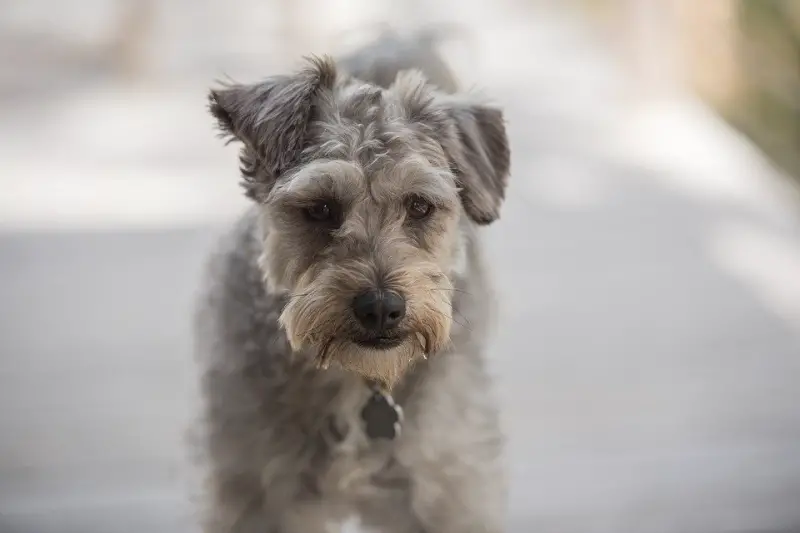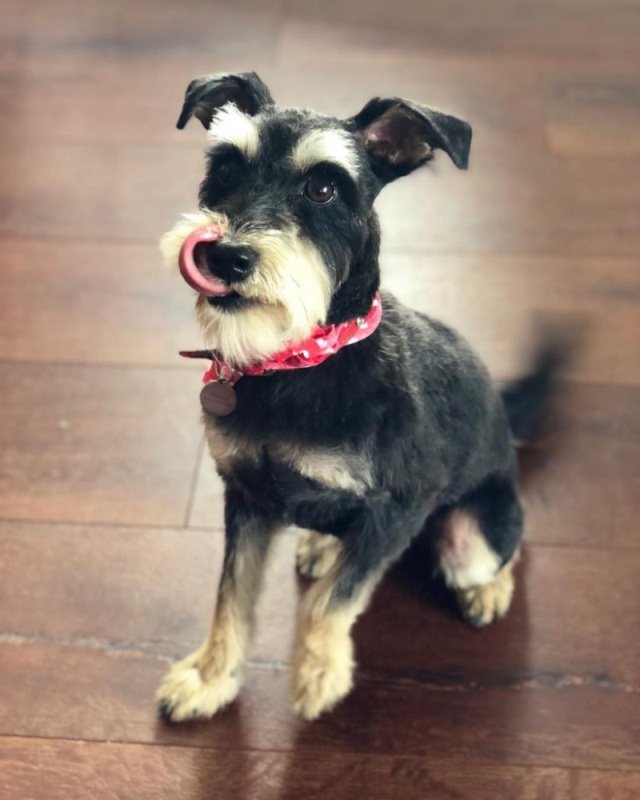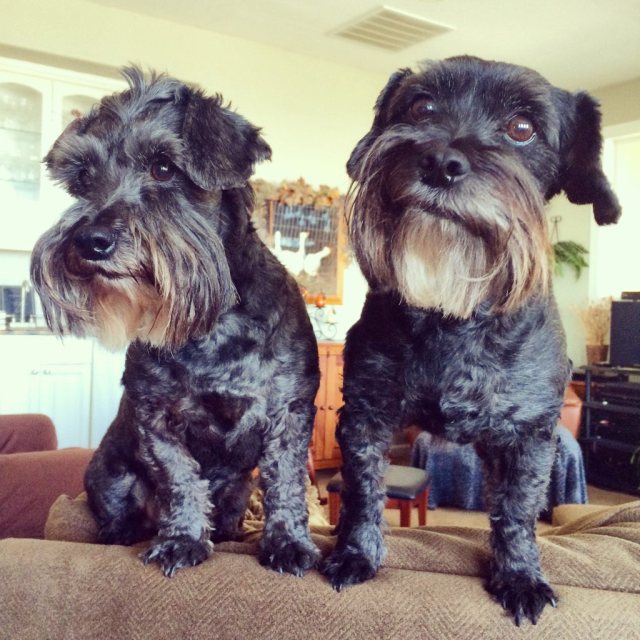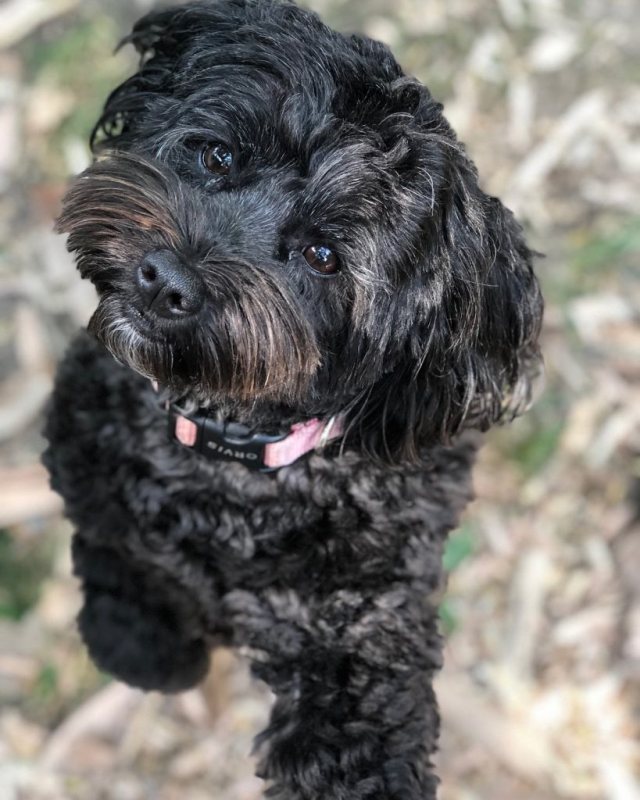The Schnoodle dog is a hybrid canine breed that is popular with families with children. Also known as Schnauzer poodle, this hybrid dog breed is a unique mix that people love to have as a pet. Perhaps you want to get your very own Schnauzer Poodle mix dog, or you already own one? If that’s the case, here are some interesting and useful info about the canine.
Schnoodle Origin
Like many other mixed or hybrid dog breeds, the Schnoodle dogs are a relatively new breed. It was during the 1980s that the schauzer poodle mix kind came into existence. At this time, there was also a growing interest among various canine owners to cross Poodle dogs with other breeds. The original goal for creating the Schnauzer Poodle mix was to breed a dog that is low-dander and low-shedding. Their breeders have succeeded in producing such a type of canines.
Breeders also produce Schnoodle puppies that are the result of breeding multigenerational mix. They bred Schnoodles with other schauzer poodle mixes. So far, there no official standards or even breed clubs this breed, though pet owners and breeders are trying to organize one.
Schnoodle Temperament
Pet owners choose pets with traits and characteristics that they find attractive. The Schnauzer poodle is an intelligent, happy, and loyal animal. They enjoy having fun, playing, and getting lots of attention from their family. Aside from being a pet, they have what it takes to be a protective watchdog.
Schnoodle temperament varies from one canine to another. Likewise, genetics usually plays a part in how the dog’s personality turns out. A Schnauzer poodle may have a watchful and suspicious trait towards other people and dogs, while others get along with other dogs and are friendly to other people. Similarly, training and socialization on puppy or adult play a crucial part in shaping its personality. However, it is advisable to train and socialize the breed when it is still a puppy. You can train or socialize an adult Schnauzer poodle, but it won’t be easy. A well-trained and friendly canine will have a well-rounded trait.
A kindergarten class for puppies is a great way to start training a schauzer poodle mix puppy. Additionally, you can polish the dog’s social skills by meeting and greeting neighbors while you are out for a stroll or walking in a busy park. Also, the dog tends to be destructive and hard-headed if it lacks any physical or mental stimulation. Likewise, children tend to get along with this dog breed. But make sure there is adult supervision prevent children from harming the dog. At the same time, kids must learn not to bother the schnauzerdoodle while it is eating or sleeping.
Other Names
Schnoodle is the common name for this dog breed. They are also fondly called a Schnauzerdoodle, Schnauzerpoo, or a Giant schnauzerdoodle if the canine is one of those more prominent types. A smaller is called a Toy Schnauzer Poodle.
Schnoodle Coats and Colors
Schnauzer Poodle coats are soft and wavy like a Schnauzer puppy. Also, the first generation of these dogs has this kind of coat. Second generation Schnoodles tend to have the curly coat of a Poodle or the Schnauzer’s wiry coat. A wavy-type coat appears in dogs that are the results of multigenerational breeding.
The snoodle dogs coats have these possible colors in either single or dual tones:
- White
- Apricot
- Silver beige
- Black
- Silver
- Black and silver
- Salt and pepper
- Red
- Blue
- Gray
- Brown
- Cream
Overall Stats
A Schnoodle has a lifespan of 10 to 15 years. They weight 20 to 70 pounds and has a height of 1 foot, 3 inches up to 2 feet, 2 inches tall at its shoulders. However, there is no single standard for their sizes, and it often depends on what type of Schnoodles you have:
- Standards have a height of 15 to 26 inches and weigh about 20 to 75 pounds
- Miniatures have a height of 12 to 15 inches and weigh about 13 to 20 pounds
- Toy Schnoodles have a height of 10 to 12 inches and weigh about 6 to 10 pounds
Grooming Needs
Grooming a Schnoodle Dogs (or any other dog) is a vital part of its care. Here are some tips on grooming your fur baby:
Coat maintenance
Their coat is one thing that makes your dog beautiful. However, if you don’t brush it often, it can become matted and messed up. If the coat is rough and wiry, it needs weekly brushing. Likewise, your pet may require regular trimming to remove dead hair and keep it tidy. Soft wavy coats need only brushing at least once or twice a week. Lastly, a curly coat needs regular brushing and hair clipping every six to eight weeks. Bathing the dog is also essential to maintain the coat’s softness. You can brush the skin after the bath, and when drying it, you can use a hairdryer.
Physical checkup
Give the dog’s body a thorough check to find early signs of skin problems or infection. Check the ears for dirt, bad odor, or redness once a week to mitigate disease. Look out for soreness, rashes, redness, inflammation, or tenderness too. The eyes must be free from discharge or redness. The canine’s ears are tender spots that need cleaning. Use a cotton ball with a gentle pH-balanced ear cleaner weekly to clean the ears.
Nail trimming
Usually, dogs wear down their toenails the natural way. But in some cases, the nails can become too long. To determine if the canine needs nail trimming, listen carefully to it walking or running on a floor. If you hear clicking noises, then it’s an indicator that you need to shorten the nails via trimming. You can do the nail trimmings yourself or hire an expert groomer instead. You spend a bit of money in hiring an expert groomer, but it’s better than risking an injury to your pet.
Dental health
Tartar and bacteria tend to build up in the canine’s teeth. If left unchecked, they may develop gum disease and bad breath. The solution to this problem is to brush the teeth daily or two to three times a week. Daily teeth brushing are a much better option. Apples and carrots can also help keep your dog’s teeth healthy and clean. Celery can freshen the canine’s breath. If giving apples, make sure to remove the core and seeds of an apple before feeding your pet with it. Likewise, cut up the fruit and vegetables to make it easier for the dog to eat and digest.
Schnoodles can be touchy when someone touches them. They are particularly sensitive to their feet. This touchiness can be a problem since they will not stand still or become agitated during grooming. Try to accustom your pet to being handled, brushed, and examined while it is still a puppy. Also, make grooming a positive experience for the dog and praise as well as reward it for its efforts.
Schnoodle Health Issues
It’s a fact that a schnauzerpoodle and other dog breeds have various health issues affecting them. Some of these problems are preventable, while others are inherent within their breed. Here are three examples of health problems that affect these canine breeds:
- Patellar luxation – It is a common problem that affects various dog breeds, especially the smaller ones. Patellar luxation or slipped stifles condition is when the knee joint (usually the hind leg) of the dog does not fit in the bone joints. As a result, the knee joint slides in and out. It can cause canine pain and could potentially cripple them. However, with proper treatment, a dog can lead a relatively healthy life.
- Addison’s Disease or hypoadrenocorticism – This particular condition is a serious one for the canine that possesses it. Hypoadrenocorticism occurs when the dog’s adrenal gland produces insufficient hormones. The disease in its severe state causes the heart to improperly function due to high potassium levels. It can lead to severe shock and even death. The symptoms of Addison’s Disease may resemble that of other conditions, but poor appetite, low energy, and vomiting are signs of the disease. A veterinarian can confirm hypoadrenocorticism via a series of diagnostic tests.
- Gastric Torsion or Bloating – Usually, bloating affects large dog breeds that have deep chests. It can affect schnauzerpoodles, too, but the chances of affecting a small dog are low. Giant Schnoodle dogs have a substantial probability of bloating. It can occur when a canine eats too many large meals per day, drinks water in large volumes, and vigorously exercises after a heavy meal. Gas and air distend the dog’s stomach and cause it to twist (Torsion) within. Your pet may not be able to get rid of the excess air, and unable to belch or vomit. As a result, the condition blocks the blood flow into the dog’s heart, and the blood pressure will drop. Once the canine goes into shock due to low blood pressure, it needs immediate medical attention before the bloat becomes fatal.
If you correctly suspect that something is wrong with your pet’s health, do not hesitate to go to a veterinarian. A well-timed checkup will show what is wrong with a schnauzerpoodle and deal with the health problem early on.
Tips on Buying a Schnoodle Puppy
If you have the money to buy a Schnoodle puppy, then you must know how to get your money’s worth. Here are some tips to keep in mind:
Do not buy a pup from a puppy mill. Puppy mills produce a sub-standard litter. Sometimes the puppies are not the dog breeds that you want as a pet. Therefore, buy a pup from a legitimate breeder who has the credentials for producing high-quality pups.
Visit the Schnoodle breeders yourself. You can personally ask any other question concerning the puppy, such as its pedigree. Likewise, you can get first-hand information on its vaccination and health condition. A personal visit is a good chance for you to see the breeding kennels condition and see the puppy’s parents. The pup’s bloodline and its surroundings play an important part in shaping its temperament.
Be wary of Schnauzer Poodle mix puppies sold online as some of them are scams. Online scammers will usually post images of puppies and sell them for a meager price. These puppy “sellers” will also ask for money upfront from buyers before delivering the pup. Do not pay a deposit or hand out money to the seller without seeing the puppy first.
Schnoodle Dogs Price
A Schnoodle puppy can be quite expensive, and if you are willing to have one, the price should not be a question.
The pup’s price depends on several factors like their pedigree, the characteristics of their coat, the value of its parents. Breeders also consider the number of puppies currently available. Additionally, puppy sizes also dictate the pup’s price tag. You could be paying less for a small one compared to large size types.
- Giant – $1600
- Standard – $1300
- Miniature – $1000
The list above shows the standard prices, but for puppies that belong to later generations, their price tag tends to be on the low side.
If a Schnoodle pup’s price tag is lower than usual and you get the feeling that it is too good to be true, the chances are that your hunch is right. These particular puppies with meager prices are not high-quality. More so, their pedigree, as well as physical health, is questionable. You may be tempted to buy such a cheap pet, but you will just be wasting your money on a sub-standard puppy.
MORE POPULAR POODLE MIXES
Recognized Clubs
A Schoondle dog still lacks recognition from the American Kennel Club (AKC) due to it being a hybrid breed. However, the breed does have recognition from these clubs below:
- American Canine Hybrid Club (ACHC)
- Designer Dogs Kennel Club (DDKC)
- Dog Registry of America, Inc. (DRA)
- International Designer Canine Registry (IDCR)
- Designer Breed Registry (DBR)
Consequently, if you are looking for Schnoodles rescue clubs to adopt, you can try contacting Poo-Mix Rescue.
Poo-Mix Rescue is a virtual rescue operation meaning that they don’t have rescue facilities and physical shelters. However, they have contact with shelters throughout the USA and Canada. They also have a list of dogs up for adoption on their website. The Poo-Mix Rescue site is the premier source of info for adopting not just Schnoodles, but any Poodle mix breed.
Conclusion
These are the essential information on a Schnoodle dog, and there’s no denying that this is one superb pet. However, now that you know some things about them, you must consider the impact of having them in your life. Do you have time to interact and play with this high-energy pet? Will the dog be happy and content in your home? Can you take care of its physical health and provide comfort?
If you think that you don’t have what it takes to own an unusual pet like this, don’t get one. On the other hand, if you believe that you have the makings of a great pet parent, then go for it. You won’t regret having this canine as a pet, and you love having them around.
MORE DOG BREEDS




